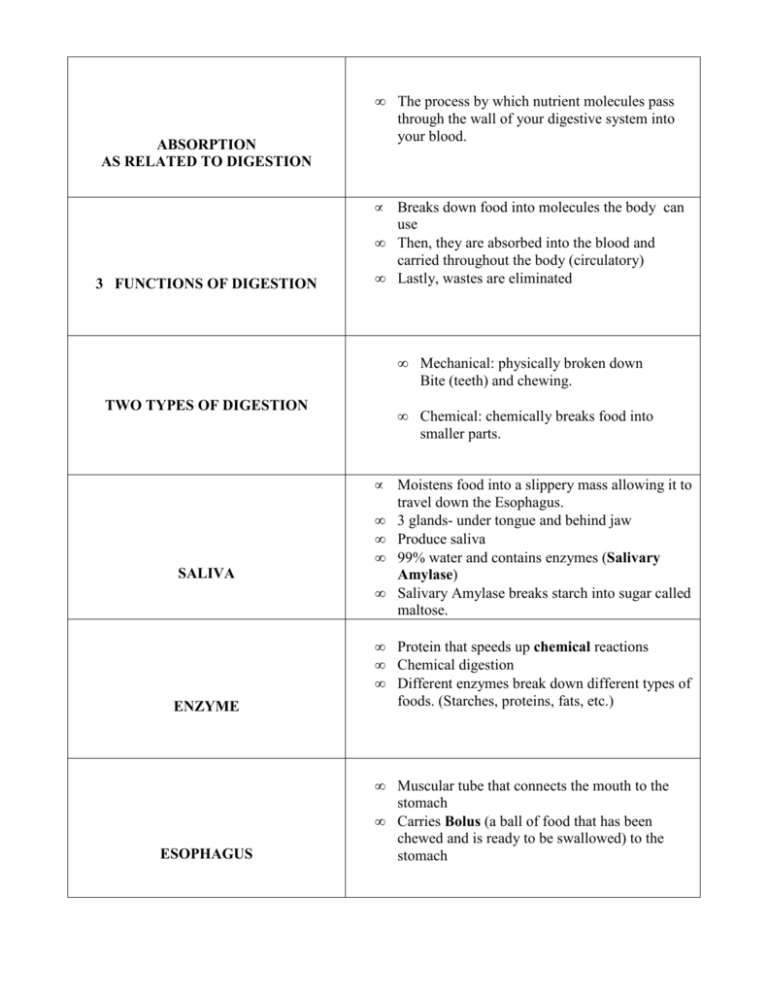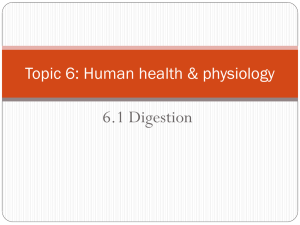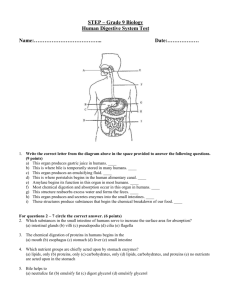Digestive system study guide
advertisement

• The process by which nutrient molecules pass through the wall of your digestive system into your blood. • Breaks down food into molecules the body can use Then, they are absorbed into the blood and carried throughout the body (circulatory) Lastly, wastes are eliminated ABSORPTION AS RELATED TO DIGESTION • 3 FUNCTIONS OF DIGESTION • TWO TYPES OF DIGESTION • • • • SALIVA • Mechanical: physically broken down Bite (teeth) and chewing. • Chemical: chemically breaks food into smaller parts. Moistens food into a slippery mass allowing it to travel down the Esophagus. 3 glands- under tongue and behind jaw Produce saliva 99% water and contains enzymes (Salivary Amylase) Salivary Amylase breaks starch into sugar called maltose. • • • Protein that speeds up chemical reactions Chemical digestion Different enzymes break down different types of foods. (Starches, proteins, fats, etc.) • Muscular tube that connects the mouth to the stomach Carries Bolus (a ball of food that has been chewed and is ready to be swallowed) to the stomach ENZYME • ESOPHAGUS • • Seals off the trachea while food is being swallowed. • A flap of gum like tissue that covers the nasal opening. • Involuntary waves of the esophagus contracting to push the food to the stomach. These contractions are called peristaltic waves. EPIGLOTTIS ULVA PERISTALSIS • • • STOMACH • • • MUCUS Muscular located in the abdomen that contains Gastric Juices. Gastric Juices contain enzymes pepsin and rennin, which breaks down proteins. Juice also contains hydrochloric acid that combines with pepsin to break down proteins and kill microorganisms in the food. Stomach works until the food becomes a thin soupy liquid called chyme. A substance that coats and protects the lining of your stomach from the digestive juices. • • • SMALL INTESTIME • • • LIVER BILE 1 inch thick and about 20-25 feet long Most of the absorption of nutrients takes place in the small intestine. Duodenum most important part of the small intestine. Located at the start of the intestine. The chemical activities in the Duodenum are from secretions and enzymes from the liver, pancreas and the small intestine. • Large and heavy Produces chemicals that play a role in many of the body’s processes. Breaks down medicines and other substances and eliminates nitrogen for the body. Produces bile for digestion. • • A substance that aids in the digestion of fats. Produced in the liver. • Bile is produced in the Liver, stored in the gallbladder and then through tubes into the Duodenum. • An endocrine gland and a gland that produces secretions Produces pancreatic juice that enters the duodenum through the pancreatic duct. Enzymes in this juice breakdown starch, carbohydrates, proteins and fat. Inlets of Langerhans: secrets the hormone insulin. Insulin is an internal secretion, passes from the gland cell right into the bloodstream, helping the body to use sugar. • GALLBLADDER • • PANCREAS • • • Does not breakdown in the digestive system. It thickens the liquid material in the intestine allowing peristalsis to move more easily. • • Fingerlike projections in the small intestine. Increase surface area, enabling the digested food to move faster. Blood vessels running through the center of each villus allow the molecules to pass into the blood. FIBER VILLI (VILLUS SINGULAR) • • • • LARGE INTESTINE • • • RECTUM ANUS Last section of the digestive system. 5 feet long. 3 times the width of small Contains bacteria that feed on the material passing through. Make certain vitamins, K Material coming contains water and undigested food such as fiber. Water is absorbed into the blood stream and the rest is readied for elimination. • • Short tube at the end of the large intestine. Waste material is compressed into a solid form here. • A muscular opening at the end of the rectum. Digestive System Enzymes and Secretions Chart Source of Enzyme or Secretion Mouth Enzyme or Secretion Action Salivary Amylase (enzyme) Breaks down starches into sugar Pepsin (enzyme) Rennin (enzyme) Breaks down proteins into shorter chains of amino acids. Hydrochloric Acid (Secretion) Provides an acid environment for pepsin; kills bacteria Amylase (enzyme) Continues the breakdown of starch Trypsin (enzyme) Continues the breakdown of proteins Lipase (enzyme) Breaks down fats Liver Bile (secretion) Breaks down fats Small Intestine Peptidase (enzyme) Continues the breakdown of proteins Maltase (enzyme) Converts remaining sugars into glucose. Stomach Pancreas








